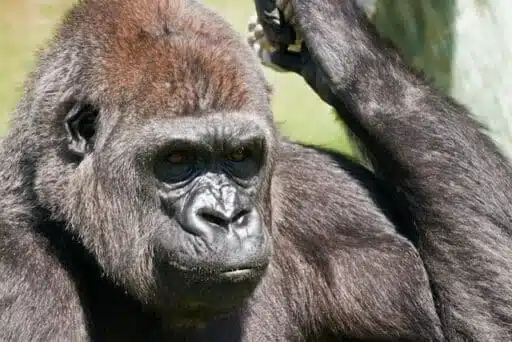How many Gorillas are left in the world? Lets have a look!
Gorillas are one of the most endangered animals today, and there are various reasons behind this. In the year of 2010, there were only 480 gorillas left in the world. Luckily the population increased to 604 when 124 newborns arrived in 2019.
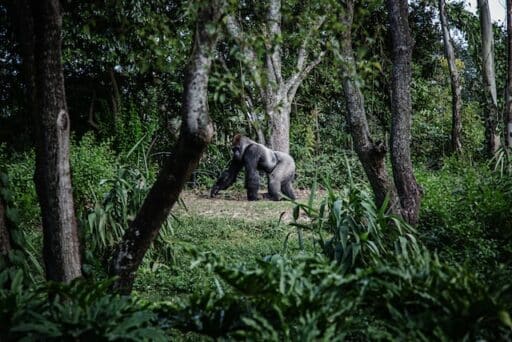
The clock is ticking for gorillas, and they find themselves teetering on the brink of extinction due to habitat degradation and diseases that have ravaged their populations in recent decades. Their status is now critically endangered, demanding our immediate attention. The stark reality is that unless we take swift action, gorillas could vanish within our own lifetimes.
In this discussion, we’ll delve into the impending threat of extinction facing these remarkable mammals, examine the current gorilla population figures, and assess the likelihood of their survival. So, without delay, let’s delve into the critical details.
Gorilla Species Found Around The Globe
Humans and gorillas have 98% of the same genetic material. You can say that they are one of humans’ closest cousins and the largest ape.
When talking about species, we can classify them into
- · Eastern Gorillas
- · Western Gorillas
Eastern Gorillas
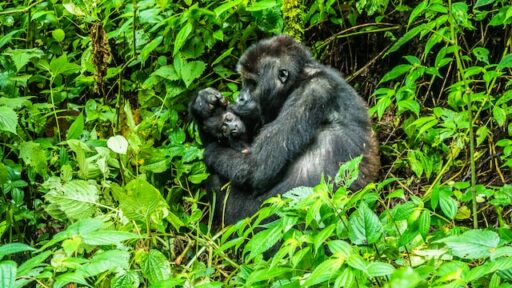
The Eastern gorillas can be found in Uganda, Rwanda, the Democratic Republic of the Congo. They are deemed to be the largest apes on the planet. The contemporary name for the Eastern lowland gorilla is the Grauer’s gorilla.
According to estimations, only about 5,000 eastern gorillas are currently left in the world. We can classify Eastern gorillas into two subspecies, and those are;
1. Mountain Gorillas
In contrast to other primates, mountain gorillas have thick, long hair and fur that keeps them warm in the chilly climate on the mountain slopes.
The continued expansion of humans in forests and mountainous areas puts mountain gorillas at risk of habitat destruction. Some are compelled to relocate farther up the chilly mountain slopes, which may be hazardous to their health.
2. Eastern Lowland Gorilla/Grauer’s Gorilla
Meet the heavyweight champion of the gorilla world—the eastern lowland gorilla. It stands out from the gorilla crowd with its beefy build, mighty mitts, and a snub nose. These gorillas call the lush lowland tropical rainforests of the eastern Democratic Republic of Congo home.
Just like their gorilla cousins, these eastern lowland giants are big fans of fruits and greens. But here’s the twist: back in the mid-90s, there were around 17,000 of these magnificent creatures. Fast forward to today, and biologists are sounding the alarm, estimating a shocking 60% decline in their population.
Western Gorillas

The most prevalent species is the western gorilla. Unlike eastern gorillas, they have a different nose structure and a lighter skin tone. It is estimated that about 316,000 western gorillas are left living in the wild.
Western lowland gorillas can be further divided into two subspecies, discussed below.
1. Western Lowland Gorilla
One of the two threatened species subspecies of the western gorilla is the western lowland gorilla. The western lowland gorilla is a calm, non-aggressive species in danger of sickness and poaching.
They knuckle-walk while crawling on all fours, bearing all their weight on their curled third and fourth fingers. Their arms are longer than their legs, and they are the smallest subspecies in the western lowland. Males are significantly bigger than females.
Their habitat runs throughout the Congo Basin, including the Central African Republic, Gabon, Cameroon, Angola, and Congo.
2. Cross River Gorilla
This species, unknown to scientists until the early 20th century, is found deep in the highlands rainforest of Cameroon and Nigeria, living among the bamboo thickets and the enormous Cross River.
Despite having small changes in the size of the skull and teeth, this subspecies of the western gorilla looks pretty much similar to the more common western lowland gorilla.
They can only be found in the wooded hills and mountains along the Nigerian border, with Cameroon at the Cross River’s headwaters.
The male Cross River gorillas can grow 5 ft 8 in (175 cm) tall and weigh 450 lbs (200 kg). On the other hand, the females are a little smaller, standing 4 ft 7 in (140 cm) tall and weighing 220 lbs (100 kg).
Threats to Gorilla’s Survival
There were reportedly fewer than four-hundred mountain gorillas left in the world in the 1980s. The future of the gorilla was uncertain with their critically low population. Luckily, that number has increased to a little over a thousand due to conservation efforts.
Today, there is a fair chance of growth of this species resulting from the efforts that have been underway over the last few decades. However, here’s a list of the most prominent threats that are the reasons causing their endangerment.
1. Poaching
Gorilla populations still found in the wild are seriously threatened by poaching for bushmeat. Their body parts are used in traditional medicines and magical charms, causing an extreme threat to the species.
Due to their poor reproductive rate, gorillas are vulnerable to population collapse that could last for decades if relatively moderate levels of poaching are allowed to continue.
Additionally, gorillas are regularly captured in traps meant for other forest animals. They are either killed or wounded as a result of illegal hunting.
2. Habitat Loss
Losing their habitat, for several different reasons, is another noticeable threat to the specie’s life. Unlike many other animals, gorillas are not adaptive to new habitats besides forests and mountains.
The rapidly deteriorating gorilla habitat brought on by mining, commercial logging, subsistence farming, and road construction activities poses a serious threat to the remaining wild gorilla populations.
Today, poachers have much easier access to previously inaccessible forest areas thanks to commercial logging, agriculture, and the developed transportation infrastructure. Likewise, these activities permit the use of vehicles to transport large quantities of bushmeat from the forest.
3. Disease
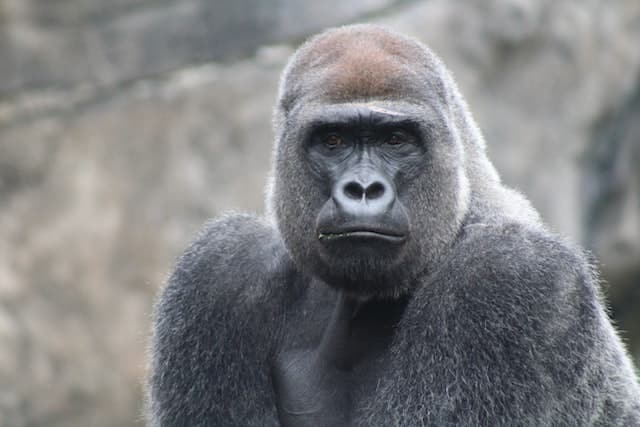
Ebola viral disease is a deadly, contagious illness that has decimated numerous populations of great apes in Africa. Ebola hemorrhagic disease epidemics have brought about large-scale ape deaths since the early 1990s.
More than 90 percent of the 600 gorillas detected as having the virus died probably due to the virus between 2002 and 2003, and the infection claimed numerous human lives.
Gorillas are prone to various human diseases because they share many characteristics with humans.
The gorillas in the mountain gorilla region are prone to contracting scabies, TB, and other infections from human transmission since they routinely raid farms and interact with people through tourism.
4. No Strict Law Enforcement
It is against the law to kill gorillas or trade in their products throughout most of the animals’ range. Despite being illegal consumers, traders and poachers are often found guilty of trading illegally because of gaps in the capacity of local law enforcement.
Making a law is not enough; authorities must strictly implement it; otherwise, it is of no benefit. So, another prominent reason for the specie’s endangerment relates to the overall governance in some of the areas where the gorillas reside.
5. Low Reproduction Rate
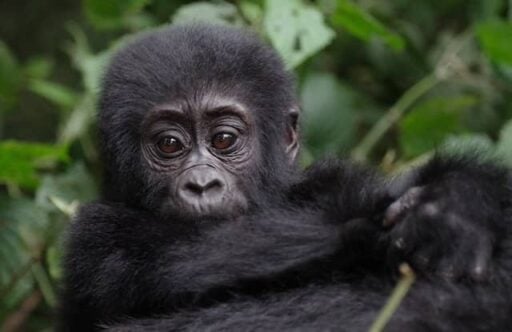
Unlike many other mammals, gorillas have a delayed reproductive process. They only have one baby at a time, raise it for several years, and then have another. Gorillas are particularly prone to population reductions because of their poor reproductive rate.
6. Forest Area Destruction
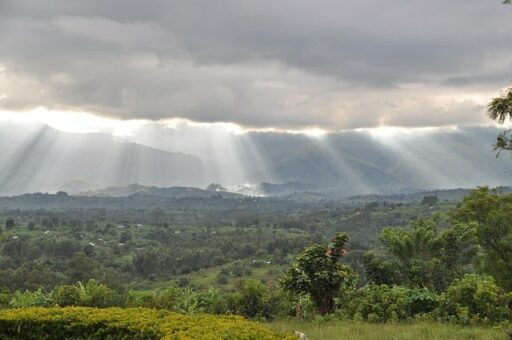
The fragmentation of forest regions has also resulted in the separation of gorilla populations. Furthermore, the construction of land mines in the forests has resulted in the deaths of many gorillas. Uncontrolled bushfires are another serious concern in the forest.
Poachers frequently leave the fire as is after a bonfire, which frequently burns the entire region. It can also happen due to minor negligence, such as throwing a lighted cigarette in the bush.
Fun Facts About Gorillas
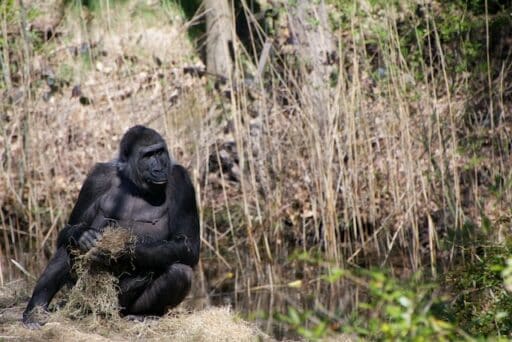
You can learn so much about gorillas; some things will make you question what you already know, and some will enchant you. Like many other creatures, gorillas have emotions, moods, and sensitivities that make each encounter unique.
Let’s find out the amazing facts about animals and what makes them different from others.
1. Gentle Giants
Gorillas are widely recognized as the largest primates. An adult mountain gorilla stands 4 to 6 feet tall on average, but they are truly gentle giants. Despite having huge bodies, they never harm other beings around them.
2. Hair Turn Grey As They Mature
A mature male’s hair begins to gray in the back, earning the name silverback. The hair on the back of a young male gorilla begins to become gray/silver as it matures. It starts to happen when they are between the ages of 10 and 12 years.
3. Different Fingerprints/Nose Patterns

Gorillas also have a distinct nose pattern that is unique to each gorilla. The nose pattern is a visible trait you can use to distinguish between two individuals who appear similar. They also have distinct fingerprints, just like humans.
4. Thick and Long Hair
Gorillas’ thick and long body hair keeps them safe from extreme weather. It allows them to survive in cold, high-altitude environments. Because gorillas live in wet tropical settings for much of the year, their hair keeps them warm.
It is especially important for mountain gorillas who live at high altitudes.
5. Strong Bite Force
Even though gorillas are pure vegetarians, that doesn’t mean they do not take action when they feel threatened. Like any other animal, gorillas use their teeth to fight against danger. The bite force of a gorilla is around 1,300 PSI.
It is significantly higher than the 1,000 PSI of a lion or tiger. So, it is advised not to mess with these animals and to be gentle with them if you come across one.
6. No Survival In New Habitat
Mountain gorillas are considered to be the most endangered species of all. They cannot survive in any setting other than their natural habitat.
7. Family Bonding
Troops are tiny family units of gorillas. These gorilla families typically comprise ten members, with one silverback as the leader. Silverbacks lead the entire troop to different locations for food while also assuring the troop’s safety.
The silverback’s mission is to protect the members of his group, even if that means dying in the process. Following the loss of a silverback, the females seek another family to join.
Gorilla subgroups can be bigger or smaller than this ratio, but they cannot include more than one dominant silverback.
8. Temporary Nests
Gorillas only stay in one location for a short period of time. Every morning, they are directly on their way in search of food. Gorillas are migratory and make their sleeping nests from twigs and grass every day, where they sleep and then migrate the next day again. Occasionally, they construct sleeping nests in trees.
9. Breeding
Gorillas typically have one baby at a time and give birth after 8.5 months. Infants are baby gorillas who nurse, which they typically do until they are approximately three years old. These infants can walk and eat on their own by the third year. Gorillas typically have one offspring at a time and seldom have twins.
About 98 percent of human DNA is similar to that of gorillas. According to their genetic similarity to humans, gorillas may be negatively affected by exposure to human illnesses because they lack essential immunities.
11. Binge Eaters

Mountain gorillas consume, primarily from plants, for around a quarter of the day. Gorillas consume leaves and stems, making up around 85% of their diet. However, they can also eat worms, snails, pests, and roots.
12. Intelligence
Since gorillas are much similar to humans in various things, they are sensible enough to do experiments. Scientists have observed wild gorillas measuring the depth of streams and rivers with sticks and building bamboo ladders for young gorillas to climb to the treetops.
Also, they have been witnessed using sticks and thin wood pieces to feed insects and leaves to their infants, kind of like cutlery.
13. Friendly Nature
In general, gorillas are thought to be friendly, peaceful, and gentle primates. Gorillas are friendly creatures that only turn hostile toward humans when they perceive a threat.
14. Amazing Apes
Because they are intelligent and have developed brains, they are also great apes like humans and chimpanzees. Like us, they can laugh, cry, and display other emotions. However, an average gorilla is around six times as powerful as the average person.
How to Contribute to the Conservation of Gorillas?
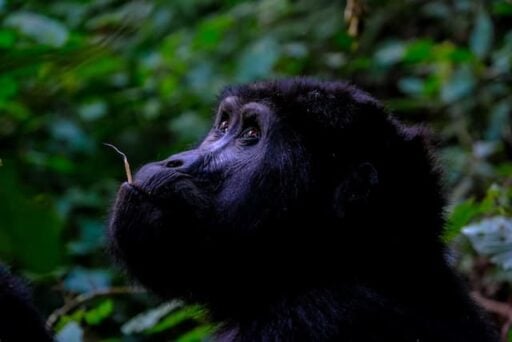
Everyone can play some role in saving gorillas from extinction. You do not need to do something extraordinary; a small action can go a long way.
1. If You Are Sick, Avoid Going On The Gorilla Hike
Due to the long separation from humans, gorillas are immunologically naive to several diseases, making them especially vulnerable to some of them. Respiratory illnesses, which can vary from minor colds to serious pneumonia, are the most frequent infections.
We highly suggest that anyone with a fever refrain from trekking gorillas to protect the animals from such infections.
2. Donate Generously
Donating money to organizations working locally to conserve the species is one of the best ways to aid mountain gorillas. Researchers have spent decades figuring out the most efficient ways to save mountain gorillas.
Most of these organizations depend on grants and contributions to support their operations. It’s crucial to assess the organization you’re considering supporting before making a financial contribution to a cause. Make sure to ascertain how well the group accomplishes its goals.
3. Avoid Purchasing Items Created With Animal Parts.
While poachers only infrequently target mountain gorillas, they frequently hunt other species in the national parks where gorillas reside. The mere presence of poachers in the forest affects the ecosystem and raises the possibility of disease transmission.
The snares that poachers lay for other animals catch gorillas as well. Wild animal fur, teeth, and ivory may be used in handicrafts and other goods sold to tourists, while bushmeat is the primary target of poaching.
Don’t purchase anything if there are any doubts regarding its provenance – this is how you can play your role in saving the animal genocide.
4. Be Concerned About Animals
Learning more about gorillas and the necessity for wildlife protection, in general, is crucial. You should be aware of the fact that wild creatures do not make good pets.
By doing so, the trade in exotic pets will be lessened while protecting people and animals. Our environment, – including threatened and endangered animals – urgently need our care, attention, and awareness.
The Bottom Line on How many Gorillas are left

| Key Points |
| Lions are carnivores, meaning that meat makes up most of their diet. In the wild, they frequently hunt zebras, wildebeest, buffalo, giraffes, and gazelles. The fruits and vegetables that gorillas consume are locally available in the wild. |
| In Africa, gorillas inhabit the jungle surrounding the continent’s mountain ranges. The only remaining sanctuary for a tiny number of Asiatic lions is the Gir Forest National Park in India. |
| An adult lion can weigh up to 500 pounds, while a giant gorilla typically weighs 440 pounds. |
| Attacks by lions result in 200 or so fatalities annually. Because they attack with the intent to kill rather than to defend themselves, lions pose a more significant threat to humans than gorillas. |
| Gorillas are more intelligent but lions have the edge in practical intelligence. |
| The lion sprints to its enemies while the gorilla moves by knuckle-walking |
The plight of gorilla species is nothing short of critical, and the clock is ticking. If we don’t step up now, these magnificent creatures may vanish within decades.
The question of how many gorillas still roam our planet is a somber one. The stark reality is that there are fewer than 101,500 gorillas left worldwide. To break it down, we’re looking at around 100,000 western lowland gorillas, 5,000 eastern lowland gorillas, 1,000 mountain gorillas, and fewer than 300 cross-river gorillas struggling to exist.
But here’s the silver lining amidst this dark cloud – numerous conservation programs are tirelessly working to rescue these species from the brink. If we can halt the ruthless poaching for bushmeat, there’s a glimmer of hope for gorilla populations to rebound in the years ahead.
Thank you for reading this article! If you want to continue reading about gorillas, read our article which discusses who would win in a fight between gorilla vs lion or best places for gorilla trekking.
- Magpie Bird Is Reunited with Her Dog Best Friend - April 24, 2024
- Dog Saves Another Dog From Drowning in Fish Pond - April 23, 2024
- Man On Motorbike Rescues Cat From Highway - April 23, 2024

